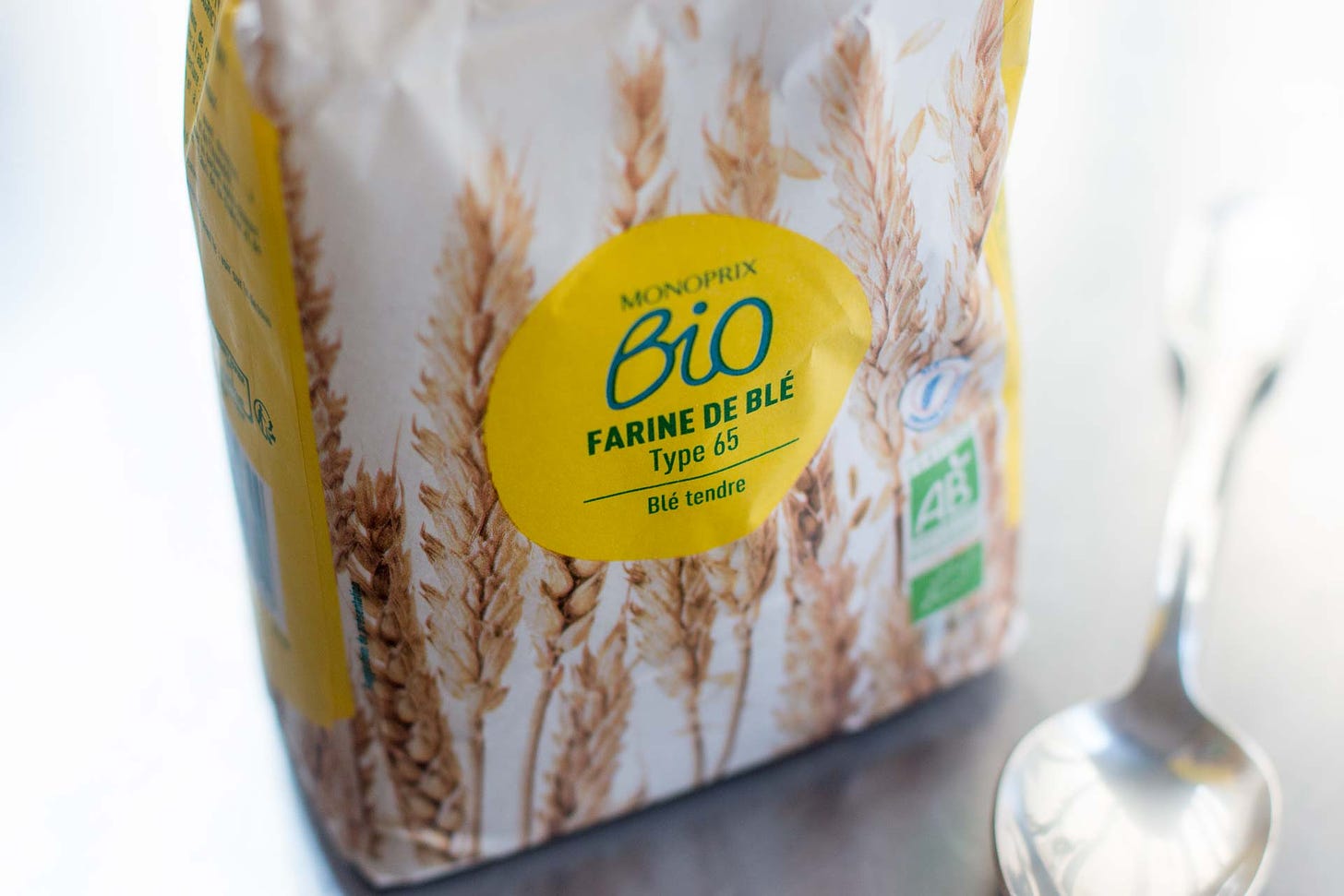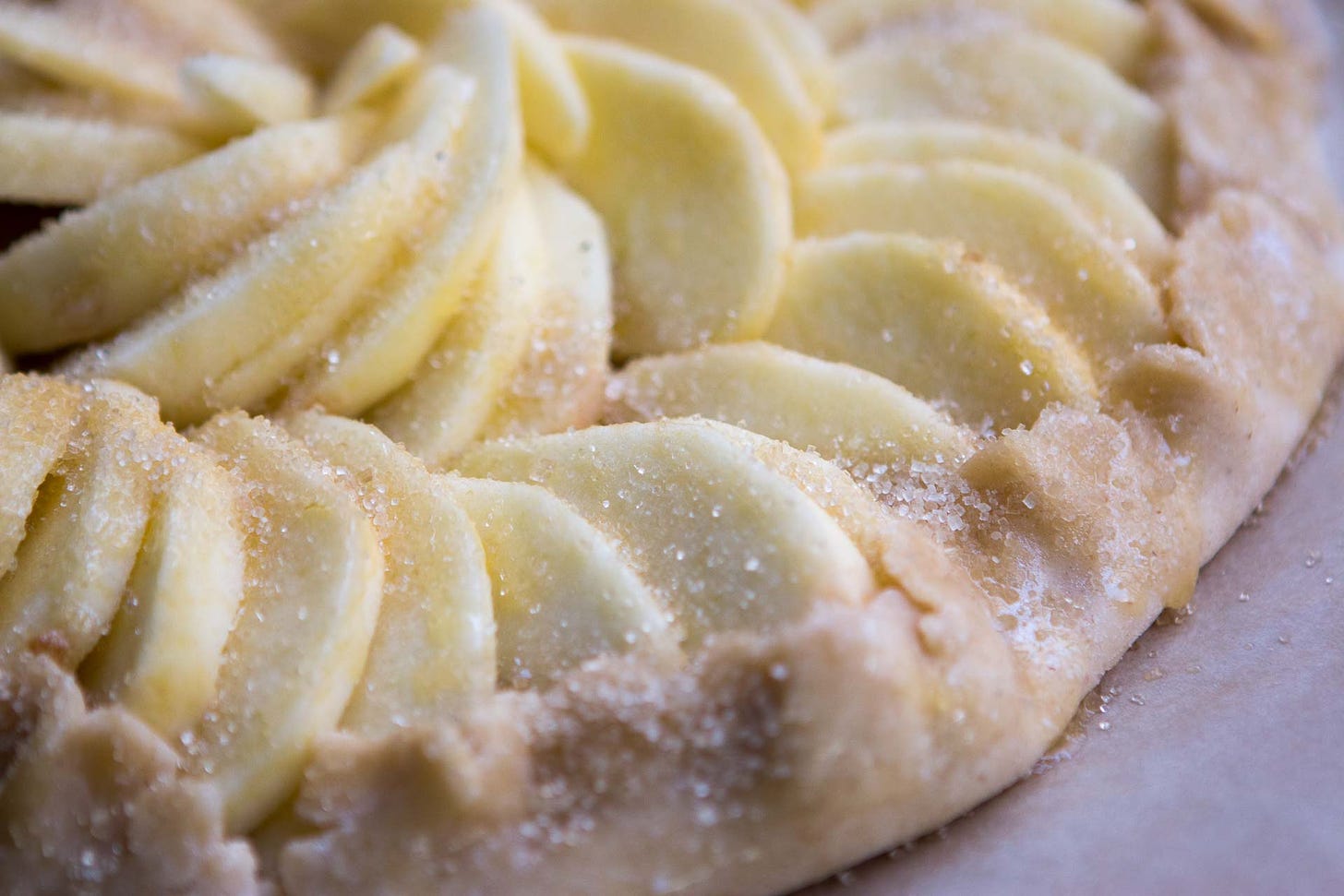For some reason, tarts like these have become known as galettes outside of France. (The Italian equivalent is the crostata.) I can’t speak for Italy, but in France, a galette is used to refer to a buckwheat crêpe.
To fact-check myself (so you don’t have to), I typed “galette aux pommes” into French Google and not a single open-face apple tart showed up on the first two pages of results. When I typed “apple galette” in English, the first two pages of Google were awash with open-face tarts with apples fanning out in any and all directions. Some had scoops of ice cream melting in the center (does anyone serve an entire tart with ice cream mounded and melting in the middle?). But most were more restrained, as you’d find in France…if you could find them in France. I’ll keep looking…
To be fair, I, and the people I worked with back in the ’90s, were likely responsible for that.
My first encounter with an open-face apple tart was after Jacques Pépin came to work with us in the pastry department at Chez Panisse and introduced us to his Apple Crunch Tart, an enclosed two-crusted tart with a crunchy, sugary topping that was a dish-less apple pie, of sorts.
After Jacques left, we eventually skipped the top crust, and they became Apple Galettes. I can’t say for sure that that was where it all started, but if anyone has any other ideas, let me know.
Recently I was going to pick up dessert at a bakery on my way home, and then I realized that…
I had a few apples on hand.
I have some experience baking.
I have flour, butter, and water.
Why not make one myself?
There is nothing more French than an apple tart and in spite of the showy versions around the internet, more than not, apple tarts in France are simple affairs. Making the dough for this couldn’t be easier. You just mix everything together in that bowl (below), then add some water.
Note: Many of us have been deeply moved by the situation that’s been unfolding in Ukraine. There’s a lot happening, too much to discuss in a food and recipe newsletter post, but it’s urgent that people get fed. The World Central Kitchen #chefsforukraine has been on the ground feeding thousands of people since the crisis started. And for the looks of things, unfortunately, there will be more to come.
If you are a free subscriber and would like to be a paid subscriber, for the next 3 days, through March 7th, 2022, 100% of subscription fees will be donated to the World Central Kitchen (minus the 10% newsletter service fee and Stripe processing fees, which are automatically deducted by the two providers.)
UPDATE: This fundraising has ended. Thanks to all who participated through March 7th. Will report back shortly in a future newsletter about the amount of contributions.
If you’d like to make a direct donation to the World Food Kitchen, you can do so here.
Another not-so-secret secret is that people in France often use the pre-made pastry dough sold already rolled out, sold in long boxes in the refrigerated section of the supermarket. You can get pâte brisée, pâte sucrée, and puff pastry.
They’re fine (and admittedly, very convenient), but none taste as good as pâte fait maison, or homemade dough. This one comes together in just a few minutes and you don’t need a stand mixer, which most French people don’t have either. You can use a pastry blender, a couple of knives or forks, or your fingers. Just make sure you don’t work the butter in too much. Bigger chunks of butter mean more flakiness, so don’t overdo it.
Once you’ve got the dough, a brief chilling allows the water to hydrate the flour, making it easier to roll out. Years ago a co-worker who trained in France at La Varenne told me, “The less water you add is directly proportional to how flaky the dough will be.” The downside is that it may crack when you roll it. Personally, I don’t think it’s the end of the world if you add more water to make it easier to roll, but thirty years later her words still ring in my head when I’m adding water to the dough, so it’s a hard habit to break.
(When you make dough on television, it’s common to add more water than normal since it’s easier to roll out on camera. I’ve never been asked to make dough on television, but if you’re ever asked, you might want to keep that in mind.)
I do have a tip for those worried about cracking edges. I’ve never talked about it because it’s a little hard to explain, but through the magic of Substack, I can easily add a video of what I do, which is knocking the edges of the dough on the counter to soften them up while turning it, shown above.
While it’s tempting to serve ice cream or whipped cream or crème fraîche with this tart, I’m pretty sure most apple tarts get consumed nature (as-is) in France. The French tend not to “pile it on” when it comes to dessert. Ice creams aren’t loaded with mix-ins, and people are happy to focus on, say…the vanilla in Flan Parisien, rather than adding six other flavors. Ditto with jam. If I add too many flavors to the pot, I’ll hear about it from Romain. It’s all about simplicity.
I glazed my tart here with quince syrup; the reduced syrup leftover from poaching quince. Quince have a lot of pectin so the liquid gels easily when reduced, although strained apricot jam also works well. You may need to warm or add a touch of water to your glaze, and if you look closely in the photos, you may see bits of quince jelly making an appearance here and there because I didn’t do a perfect job making it brushable. But c’est comme ça.
Simple Apple Tart
Serves 6
Sometimes I’ll replace a few tablespoons of the flour in the dough with spelt or whole wheat flour. It will make the dough slightly less crisp, but it gives the tart a heartier flavor.
I wouldn’t get too hung up on any particular variety of apples. Instead, go to your local market or grocer and see what they have, and decide from there. Many vendors post guides as to what their apples are good for. Just don’t use a variety, like McIntosh, that’ll turn to mush.
Keep reading with a 7-day free trial
Subscribe to David Lebovitz Newsletter to keep reading this post and get 7 days of free access to the full post archives.














